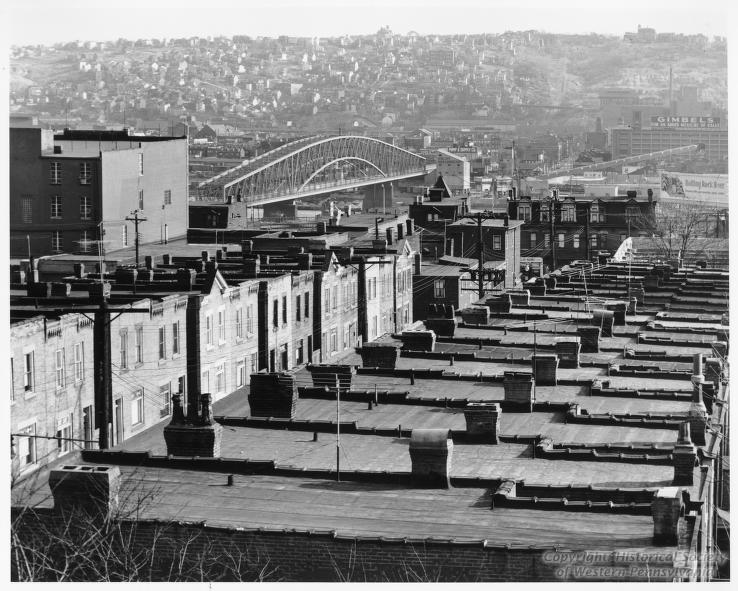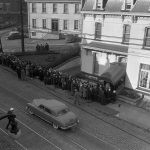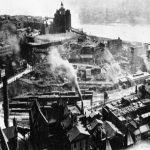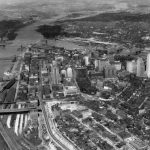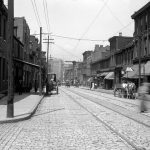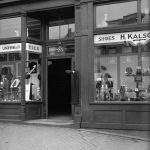History

In the early 20th century, Eastern European and other immigrants flocked to the area known as Soho and the Bluff, now called Uptown, with hopes of employment in the steel mills, coal mines, railroads, and other related industries. Ukrainians, Slovaks, Italians, Jews, Syrians, African Americans, Irish, Germans, Russians, Lebanese, Lithuanians, Armenians, Greeks, Croatians, Chinese and others were among the diverse ethnic groups that lived harmoniously in our densely built streets. This bustling community included 19th century brick row homes, retail and wholesale businesses, and a few grand institutions and homes of successful industrialists.
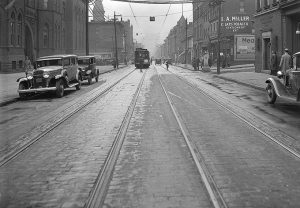
The historic Fifth Avenue High School was a good example of the blending of cultures. Built in 1894, it was the second high school built in the city, the first school in Pittsburgh to boast a sprinkler system and the first in the nation with a National Honor Society. The building remained vacant or underutilized for decades after the school closed in 1976 (the year the school basketball team took the state title). Badly deteriorated and at risk of demolition, the imposing building was purchased in 2009 by forward-looking investors who successfully transformed it into 65 market-rate loft apartments called. Fifth Avenue School Lofts, which catalyzed future development in the neighborhood.
Soho Gardens, as it was referred to in the mid-1800s, was a glorious, secluded retreat near the Birmingham Bridge, rife with fruit trees, roses, jasmine and honeysuckle. The Center for Hearing and Deaf Services building (built in 1905) at Fifth and Jumonville streets was Pittsburgh’s first Eye and Ear Institute, later becoming a first-rate hotel. 1940 Fifth Avenue, one of the nation’s earliest Elks Halls, became the city’s first chiropractic college in the early 1900s. Close by, expansive brickyards served the rapidly growing region. Uptown also was known for Film Row, a string of Hollywood-based movie exchanges, popular in the 1920s along the Boulevard of the Allies. (The last of its kind in the area, the long-vacant Paramount building received City historic designation in 2010 and is now a dynamic co-working space for Avenu, where innovative start-up companies are launched.

A small but active number of today’s residents fondly remember their childhoods in the ‘50s and ‘60s, when shops of all kinds lined Fifth and Forbes avenues, the streets were their playgrounds, and gushing fire hydrants the cool answer to steamy summers. The population began a steady decline during that time, however, compounded later by the collapse of the U.S steel industry. With poverty on the rise, a focus on downtown redevelopment, disinvestment in the Uptown community, migration to the suburbs for those who could afford it, and deterioration of the building stock, the neighborhood’s built and social fabric spiraled toward disintegration over the next four decades.
See below for more historic Uptown photos.
In the early 2000s, a small cluster of committed residents took up the charge with a renewed focus on quality of life issues and housing. Uptown Community Action Group partnered with the Urban Redevelopment Authority and neighboring Oakland Planning and Development Corporation (OPDC) to construct five affordable townhomes on land donated by Mercy Hospital on Locust St. They sold out quickly, proving the desirability of the community and good housing within financial reach. UCAG folded several years later.
In 2007, to stay ahead of approaching market forces while addressing quality of life issues, a growing group of active neighborhood stakeholders—residents, business owners and representatives of Duquesne University and Mercy Hospital—formed Uptown Partners of Pittsburgh. UP is committed to preserving the best of the past and ensuring that our future—clearly on the rise—benefits all.
In 2009, a community-wide, consensus-building planning process resulted in the Uptown Vision Plan. This document articulated priorities for future Uptown development, balancing community needs and marketplace realities.
About Uptown Partners
Staff for Uptown Partners was first hired in 2009, and its office found a compatible home alongside NeighborWorks of Western PA at 710 Fifth Avenue. The organization collaborates with its institutional partners, the City of Pittsburgh, the Urban Redevelopment Authority, Port Authority, Oakland Planning & Development Corp., Green Building Alliance, Sustainable Pittsburgh, Pittsburgh Community Reinvestment Group, neighboring community groups in the Hill, and others. Funding through McAuley Ministries, UPMC Mercy, the City and other sources allows us to carry out the Uptown Partners mission—to create a vibrant, sustainable and just community together.


